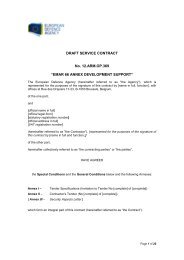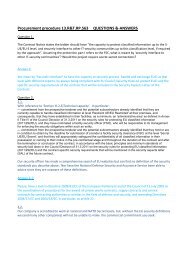capability development plan - European Defence Agency - Europa
capability development plan - European Defence Agency - Europa
capability development plan - European Defence Agency - Europa
Create successful ePaper yourself
Turn your PDF publications into a flip-book with our unique Google optimized e-Paper software.
20<br />
AN INITIAL LONG-TERM VISION<br />
FOR EUROPEAN DEFENCE CAPABILITY AND<br />
CAPACITY NEEDS<br />
4. The <strong>European</strong> <strong>capability</strong> and capacity needs referred to in the Steering Board’s tasking are those<br />
needed for the ESDP. They are only one part of the spectrum of what defence practitioners need to<br />
<strong>plan</strong> for, alongside, for example, separate national or NATO requirements. Thus, the initial long-term<br />
vision (LTV) makes no claim to influence the totality of Member States’ defence <strong>plan</strong>ning. Nor does it<br />
attempt to anticipate how ESDP itself may evolve over the next 20 years. However, the Headline Goal<br />
and <strong>European</strong> Security Strategy envisage a broad and significantly challenging set of potential<br />
missions. These include separation of warring factions by force, on the sort of scale that would have<br />
been required had a ground invasion of Kosovo in 1999 turned out to be necessary. They may also<br />
encompass stabilising operations in a failed state in the face of a determined and capable asymmetric<br />
threat. So the demands of today’s ESDP are already potentially deep and comprehensive.<br />
5. Against that background, what is offered here is a basis, a proposed foundation upon which followon<br />
work can be built, involving progressively more detailed analysis and therefore more useful<br />
guidance to those developing the defence capabilities and capacities of the future.<br />
THE GLOBAL CONTEXT - WHAT SORT OF EUROPE IN WHAT SORT OF WORLD<br />
6. Unless globalisation stops or goes into reverse, the world of 2025 is likely to be more diverse, more<br />
inter-dependent, and even more unequal. A forecast tripling of Chinese GDP will make China the<br />
second global economy; India may have overhauled Japan, to take third place. Europe will continue to<br />
grow modestly - in GDP and perhaps membership - but with its technological advantage in such areas<br />
as IT, biotechnology, and nanotechnology being steadily eroded.<br />
7. Europe will in particular be held back by low fertility rates (currently 1.5). The population may remain<br />
roughly stable, compensated by lower mortality and greater longevity. But by 2025 the effective<br />
economic old age dependency ratio (retired over 65s as a percentage of the working population aged<br />
15-64) will have risen from 37% to 48%; and the average <strong>European</strong> will be 45 years old. <strong>European</strong>s will<br />
by 2025 comprise a mere 6% of the world population. The aging of Europe’s people will lead to fierce<br />
competition for young and skilled workers. The Armed Forces recruitment pool (16 – 30 age group) will<br />
fall by over 15% by 2025.<br />
9. Globalisation will produce winners and losers, as between countries and regions, and within<br />
societies (whilst universal communication will make these disparities ever more apparent). The regions<br />
neighbouring Europe will face particular challenges. High fertility should see Africa’s population growing<br />
faster than anywhere else – up by 48% to 1.3 billion by 2025 – despite AIDS. The average African’s<br />
age is projected to be 22. Desertification may increasingly concentrate this young population in urban<br />
centres (11 African mega-cities of 5 million plus by 2025) – many of them without hope of employment.<br />
The implications for despair, humanitarian disaster and migratory pressures are obvious.<br />
10. The Middle East will see a comparable growth in its young population – a 50% increase in the<br />
working age population - with similar uncertainties as to how they are to find employment, and 70% of<br />
the population in cities by 2015. Russia, by contrast, looks likely to suffer a 10% population decline by<br />
2025.<br />
11. So the prognosis is for tensions and strong migratory pressures in the regions around Europe, at a<br />
time when Europe is becoming increasingly dependent on the rest of the world, especially for energy.<br />
Global energy demand is reckoned to rise by 50% by 2030 – oil consumption up 40%, gas up 90%.<br />
The resources are available but the question is whether investments will be made in time to avoid<br />
constant supply pressure at the margin and steady price increases. By 2025, Europe will be externally<br />
dependent for 90% of its oil and 80% of its gas. China and India in particular will drive global energy<br />
demand, and seek new sources in central Asia, Africa and the Middle East. In this and other ways,<br />
<strong>European</strong> security interests may be directly or indirectly challenged by tensions arising not only in the<br />
near neighbourhood but also further afield.<br />
8. These demographic trends will have major implications for public finances, with increasing health<br />
care and pension costs. Future public benefits to the elderly could rise from today’s spectrum of 11-<br />
16% of national GDPs to 17-33% over the next 4 decades. Low economic growth and high<br />
unemployment could further exacerbate fiscal pressures on national budgets as unemployment and<br />
social benefits are funded by a decreasing taxpaying population. Inevitably, costs of armed forces<br />
personnel will also rise.<br />
© sxc.hu<br />
FUTURE TRENDS FROM THE CAPABILITY DEVELOPMENT PLAN

















